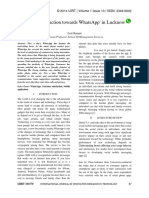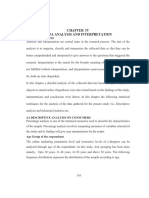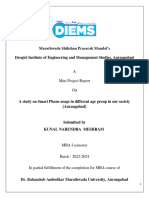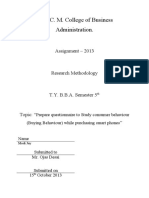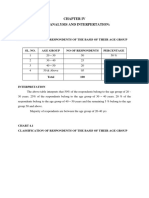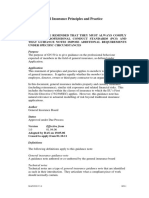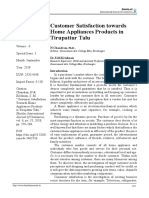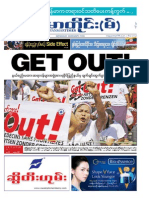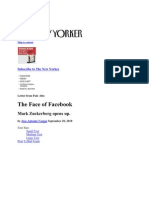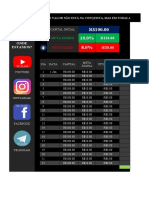CHAPTER 4
DATA ANALYSIS AND INTERPRETATION
1.
AGE OF THE RESPONDENTS :
Age
customer is
that
are
more
than
ever
S. No
1
2
3
4
Age
Below 18
19 24
25 29
Above 30
Total
No. Of respondents
12
96
85
57
250
Percentage
4.8%
38.4%
34%
22.8%
100
of
the
the concept
consumers
empowered
because
they can access information about products and services in real time.
Table 4.1
AGE OF THE RESPONDENTS
INTERPRETATION:
From the above table ,it can be observed that 38.4% of the respondents were belongs to
under the age group of 19-24 year ,34% of the respondents were under the age group of 25-29
year, 22.8% of the respondents were under age group of above 50 years and 4.8% of the
respondents are below 18 years.
INFERENCE:
The majority (38.4%) of the respondents belongs to the age group of 19-24 years.
�Chart 4.1
AGE OF THE RESPONDENTS
45.00%
40.00%
38.40%
34.00%
35.00%
30.00%
25.00%
22.80%
20.00%
15.00%
10.00%
5.00%
4.80%
0.00%
Below 18
19 24
25 29
Above 30
�2.
GENDER:
The marketers divide the market into smaller segments based on gender. Both men
and women have different interests and preferences, and thus the need for segmentation.
Table 4.2
GENDER
S. No
Gender
1
Male
2
Female
Total
No. of Respondents
145
Percentage
58%
105
250
42%
100
INTERPRETATION :
From the above table, it can be inferred that 58% of the respondents are male and 42% of
the respondents are female.
INFERENCE :
It is inferred that the majority 58% of the respondents are male.
�Chart 4.2
GENDER
60%
50%
40%
30%
58%
42%
20%
10%
0%
Male
Female
�3.
MARITAL STATUS:
The research can also be as per the marital status of the individuals. Every research has
the bachelors and married couples for identifying their taste and preferences.
Table 4.3
MARITAL STATUS
S.No
Marital Status
No. of respondents
Percentage
Married
102
40.8%
Unmarried
148
59.2%
Total
250
100
INTERPRETATION:
It is understood from the above table that 59.2% of the respondents are unmarried and the
remaining 40.8% of the respondents are married.
INFERENCE:
It can be concluded that majority (59.2%) of the respondents are unmarried.
�Chart 4.3
MARITAL STATUS
59.20%
60.00%
50.00%
40.80%
40.00%
30.00%
20.00%
10.00%
0.00%
Married
Unmarried
�4. EDUCATION QUALIFICATION :
Educational qualifications are the degrees, diplomas, certificates, professional titles and
so forth that an individual has acquired whether by full-time study, It is measured for observing
the usage of Whatsapp social media under the respondents educational status.
Table 4.4
EDUCATION QUALIFICATION
S.No
1
2
3
4
Education qualification
School level
Graduate
Post graduate
Professional
Total
No of respondents
Percentage
45
102
67
36
250
18%
40.8%
26.8%
14.4%
100
INTERPRETATION:
Out of 250 respondents 40.8% of the respondents were graduates 26.8% of the
respondents were post graduates, 18% of the respondents were with school level education and
14.4% respondents were professionals.
INFERENCE:
It can be concluded that majority (40.8%) of the respondents were graduates.
�Chart 4.4
EDUCATION QUALIFICATION
45%
40.80%
40%
35%
26.80%
30%
25%
20%
18.00%
14.40%
15%
10%
5%
0%
School level
Graduate
Post graduate
Professional
�5. OCCUPATION:
A system of classifying people according to occupation, based originally on information
obtained by government census and subsequently developed by market research. The
classifications are used for research to identifying the needs of the respondents according to their
occupation.
Table 4.5
OCCUPATION
S. No
Occupation
No. of respondents
Percentage
Salaried
90
36%
Business
38
15.2%
Agriculture
13
5.2%
Self employed
16
6.4%
Student
54
21.6%
Home maker
29
11.6%
Retired
10
4%
Total
250
100
INTERPRETATION:
The table indicates that 36% of the respondents were salaried people, 21.6% of the
respondents were students, 15.2% of the respondents were doing business, 11.6% of the
respondents were homemakers, 6.4% of the respondents were self employed, 5.2 % of the
respondents were agriculture and 4% of the respondents were retired persons.
INFERENCE:
Majority of (36%) respondents are salaried people.
�Chart 4.5
OCCUPATION
40%
36.00%
35%
30%
25%
21.60%
20%
15.20%
15%
11.60%
10%
5.20%
6.40%
4.00%
5%
Re
tir
ed
m
ak
er
e
H
om
St
ud
en
t
Ag
ric
ul
tu
re
Se
lf
em
pl
oy
ed
Bu
si
ne
ss
Sa
la
rie
d
0%
�6. MONTHLY INCOME :
Marketers divide the consumers into small segments as per their income. Individuals are
classified into segments according to their monthly earnings.
Table 4.6
MONTHLY INCOME
S. No
Monthly Income
No. of Respondents
Percentage
Below Rs. 10,000
133
53.2%
Rs. 10,001-25,000
86
34.4%
Rs.25,001-50,000
22
8.8%
Above Rs. 50,000
3.6%
250
100
Total
INTERPRETATION:
The table shows that 53.2% of the respondents were belongs to the monthly income of
below rs.10,000 , 34.4% of the respondents were income level group of Rs 10,001 25,000 ,
8.8% of the respondents were income level group of Rs 25,001 50,000 and 3.6% of the
respondents were income group of above Rs 50,000.
INFERENCE:
It is concluded from the analysis that majority (53.2%) of respondents belongs to the
income level of below Rs 10,000.
�Chart 4.6
MONTHLY INCOME
60.00%
53.20%
50.00%
34.40%
40.00%
30.00%
20.00%
8.80%
10.00%
3.60%
50
,0
00
Rs
.
Ab
ov
e
Rs
.2
5,
00
150
,0
00
10
,0
01
-2
5,
00
0
Rs
.
Be
lo
w
Rs
.1
0,
00
0
0.00%
�7. SOCIAL MESSAGING APPS:
Social messaging or social messaging applications or chat applications are instant
messaging or mobile messaging (Short Message Service/SMS) clients that are built
around social networking platforms. Some examples of popular social messaging include
BlackBerry Messenger, Facebook Messenger, Google Hangouts, KakaoTalk, Line,
WeChat, and WhatsApp. While both require internet connection, social messaging apps
differ from traditional IMs because they don't require a computer to use; the chat
applications run particularly on smartphone devices, where it challenges other widely
used mobile features, such as calling, texting, and emailing. Chat applications are topping
the iOS and Android most downloaded applications lists. More and more people are
upgrading from feature phones to smartphones accelerating the move from traditional
calling and SMS (which are paid services) to social messaging (which are generally
fermium or subscription-based), to become the dominant way of staying in touch on the
phone, because it is generally cheaper to send IM messages via social messaging than to
send SMS (via mobile company), not limited to the 140-character limit of SMS, and they
have more features than regular texting.
Among other features such as text chat, group chat, message notifications, status
updates, and media (file) sharing, one specific aspect of social messaging platforms that
made it popular was the usage of stickers or little rich images to depict mood and convey
messages in non-verbal format. While some stickers can be downloaded for free, some
are for purchase only, and become one of the way the developers to generate revenue.
Another feature of social messaging are in-app services / utilities, such as sticker camera
(where sticker images would be added to the resulting picture), social games, other
virtual items, business accounts and its integration with other devices, such as vending
machines,
�Table 4.7
SOCIAL MESSAGING APPS
S. No
Social networks apps
Aware
Unaware
Whats app
220(88%)
30(12%)
Face book
255(98%)
5(2%)
IMO
150(60%)
100(40%)
Hike
99(39.6%)
151(60.4%)
Twitter
56(22.4%)
194(77.6%)
Soma
36(14.4%)
214(85.6%)
Line
186(74.4%)
64(25.6%)
Way2sms
149(59.6%)
101(46.4%)
Glide
22(8.8%)
228(91.21%)
10
Skype
163(65.2%)
87(34.8%)
INTERPRETATION:
It is understood above table that out of 250 respondents, 88% of them aware
Whatsapp and the rest 12% of the respondents unaware about it like wise 98% of the
respondents aware Facebook and only 2% of them unaware it. There are 60% of them aware
IMO and the rest 40% of the respondents unaware about it like wise 39.6% of the respondents
aware Hike and only 60.4% of them unaware it. There are 22.4% of them aware Twitter and the
rest 77.6% of the respondents unaware about it like wise 14.4% of the respondents aware Soma
and only 85.6% of them unaware it. There are 74.4% of them aware Line and the rest 25.6% of
the respondents unaware about it like wise 59.6% of the respondents aware Way2sms and only
46.4% of them unaware it. There are 8.8% of them aware Glide and the rest 91.21% of the
respondents unaware about it like wise 65.2% of the respondents aware Skype and only 34.8%
of them unaware it.
INFERENCE:
The majority of 98% of the respondents aware Facebook and 91.21% of the respondents
unaware Glide.
�Chart 4.7
SOCIAL MESSAGING APPS
Chart Title
120.00%
98.00%
100.00%
88.00%
91.00%
85.60%
77.60%
80.00%
60.00%
60.00%
74.40%
60.40%
65.20%
59.60%
46.40%
40.00%39.60%
40.00%
34.80%
25.60%
22.40%
20.00%
14.40%
12.00%
8.80%
2.00%
0.00%
Whats app Face book
IMO
Hike
Twitter
Aware
Soma
Unaware
Line
Way 2 sms
Glide
Skype
�8. SOURCE OF AWARENESS:
Awareness, or more specifically brand awareness, can be described as the extent to which an
individual is familiar with a particular product, service, or brand. There are two forms of
awareness: top-of-mind and aided-recall. Top-of-mind is when a product or brand comes to mind
first when a customer is thinking of a particular industry. A prime example is Nike as this brand
comes to mind when many think of sports/athletics apparel. Aided-recall, on the other hand, is
when a customer remembers a brand when prompted or provided with a cue.
Table 4.8
SOURCE OF AWARENESS
S. No
Sources
No of respondents
Percentage
Friends
135
54%
Relatives
32
12.8%
Internet
58
23.2%
Other medias
25
10%
250
100
Total
INTERPRETATION:
From the above table you can be inferred that (54%) of respondents were known
Whatsapp usage through their friends, 23.2% of the respondents were known through
internet,12.8% of respondents were known through relatives,10% of the respondents are known
it through other medias
INFFERENCE:
It can be concluded that the majority (54%) of the respondents were known Whatsapp
usage through their friends.
�Chart 4.8
SOURCE OF AWARENESS
60%
50%
40%
30%
54.00%
20%
23.20%
10%
12.80%
10.00%
0%
Friends
Relatives
Internet
Other medias
�9. PURPOSE OF USING WHATSAPP:
WhatsApp Messenger is a proprietary, cross-platform, encrypted instant messaging client for
smartphones. It uses the Internet to send text messages, documents, images, video, user location and
audio messages to other users using standard cellular mobile numbers.
Table 4.9
PURPOSE OF USING WHATSAPP
S. No
Purpose
No of respondents
Percentage
Academic work
18
General information
116
44
Chatting
92
36.8
Business purpose
12
6.2
Social contacts
12
250
100
Total
INTERPRRETATION
According to the above table, out of 250 respondents, 44% of the respondents using
Whatsapp for general information 36.8% of the respondents are utilized it for chatting, 7 % of
respondents are using it for academic work, 6.2 % of the respondents are using it for business
purpose and 6% of respondents are using Whatsapp using for social contacts.
INFFERENCE
Majority of (44%) respondents are using Whatsapp for general informations.
Chart 4.9
�PURPOSE OF USING WHATSAPP
44
4500%
4000%
36.8
3500%
3000%
2500%
2000%
1500%
1000%
6.2
500%
0.07
10. REASONS FOR PREFERRING:
co
nt
ac
ts
So
ci
al
Ch
at
tin
g
Ac
ad
em
ic
wo
rk
0%
�Most people would have a list of their friends' phone numbers. After all, we've all had
phone numbers long before any social media or instant messaging apps became the norm. It
would then be highly convenient and useful to be able to instantly text someone, instead of
first having to populate your contact list by asking our friend for their social networks.
Table 4.10
REASONS FOR PREFERRING
S.No
Reasons
No. of Respondents
Percentage
Is more convenience in using
32
12.8%
IT helps to communicate fastly and instantly
60
24%
It helps to make aware about social issues among public
64
25.6%
It helps to reach the people at low cost
26
10.4%
Unlimited messaging & no restriction on size of message
28
11.2%
Suitable for sending all types of messages.
40
16%
250
100
Total
INTERPRETATION :
From the above table ,it can be inferred that out of 250 respondents 25.6% of the
respondents feel that the reasons for preferring Whatsapp is to make aware about social issues
among the public 24% of them expressed that the Whatapp helps to communicate fastly and
instantly, 16% of them reveals that suitability for sending all type of messages is the main the
reason for preferring,12.8% of the respondents of the respondents reasons is its convenience in
using 11.2%of them preferred it for unlimited messaging & no restriction on size of messages
and 10.4% of them is telling the reasons of reaching the people at low cost.
INFERENCE:
It concluded that majority 25.6% of the respondents having aware about social issues among
public.
�Chart 4.10
REASONS FOR PREFERRING
30.00%
25.00%
20.00%
15.00%
24%
26%
10.00%
16%
13%
10%
5.00%
to
It
he
lp
s
Is
re
ac
h
or
e
th
e
pe
op
le
co
nv
en
ie
nc
e
in
at
lo
w
co
st
us
in
g
0.00%
11. PERIOD OF USING WHATSAPP:
Table 4.11
11%
�PERIOD OF USING WHATSAPP
S. No
Period
No. of Respondents
Percentage
Less than 6 months
37
14.8%
6 month 1 year
72
28.8%
1 year 2 years
85
34%
More than 2 years
56
22.4%
250
100
Total
INTERPRETATION :
In the above table 34% of the respondents used the whatsapp for 1 year to 2 years 28.8%
of the respondents were used the whatsapp for 6 months to 1 year, 22.4% of the respondents
used whatsapp for more than 2 years , 14.8% of the respondents used whatsapp for less than 6
months.
INFERENCE :
The majority (34%) of the respondents used the whatsapp for 1 year to 2 years.
Chart 4.11
�PERIOD OF USING WHATSAPP
35.00%
30.00%
25.00%
20.00%
34.00%
28.80%
15.00%
22.40%
10.00%
14.80%
5.00%
12. TYPES OF PHONE USED FOR WHATSAPP:
ye
ar
s
M
or
e
th
an
ye
ar
s
2
ye
ar
on
th
m
6
Le
ss
th
an
on
th
s
ye
ar
0.00%
�Smartphone apps have become immensely popular in this day and age. The set status
messages on WhatsApp profile are usually comprised of one sentence, but there are shorter than
these statuses which are composed using just a few five to six words are also in demand these
days. The short status for WhatsApp about life are the most cherished type of short WhatsApp
statuses could be used to set our WhatsApp profile status according to our mood. Whatsapp is
suitable for every android operating system.
Table 4.12
TYPES OF PHONE USED FOR WHATSAPP
S.no
Types of phone
No. of respondents Percentage
Touch screen
232
92.8%
Qwerty keyboard
18
7.2%
Total
250
100
INTERPRETATION:
From the above table out of 250 respondents 92.8% of the respondents are using touch
screen mobile phone, another 7.2% of the respondents using QWERTY keyboard.
INFERENCE:
The majority 92.8% of the respondents are using touch screen mobile phone.
Chart 4.12
TYPES OF PHONE USED FOR WHATSAPP
�7%
Touch screen
Qwerty keyboard
93%
13. TYPES OF CONNECTION USED BY THE RESPONDENTS:
Table 4.13
�TYPES OF CONNECTION USED BY THE RESPONDENTS
S.No
Connection
No of respondents
Percentage
Prepaid
215
86%
Postpaid
35
14%
250
100
Total
INTERPRETATION:
According to the above table, out of 250 respondents 86 % of the respondents using
prepaid connection, remaining 14 % of the respondents are using postpaid connection.
INFERENCE:
It can be concluded that majority of the respondents are using prepaid connection.
Chart 4.13
TYPES OF CONNECTION USED BY THE RESPONDENTS
�14%
Prepaid
Postpaid
86%
14. NETWORK SERVICE USED FOR WHATSAPP:
Table 4.14
NETWORK SERVICE USED FOR WHATSAPP
S.No
Network service
No. of respondents
Percentage
Aircel
102
40.8%
Airtel
86
34.4%
BSNL
20
8%
Vodafone
28
11.2%
Tata Docomo
1.4%
Idea
2%
Reliance
2.2%
250
100
Total
INTERPRETATION:
From the above table inferred that out of 250 respondents 40.8% of the respondents used
aircel network, 34.4% of the respondents used airtel network, 11.2 % of the respondents used
Vodafone , 8% of the respondents used BSNL , 2.2 % of the respondents used reliance , 2% of
the respondents used IDEA and 1.4 % of the respondents used tata docomo.
INFERENCE:
It is noted from the analysis that majority of the respondents used aircel network.
Table 4.14
NETWORK SERVICE USED FOR WHATSAPP
�45.00%
40.80%
40.00%
34.40%
35.00%
30.00%
25.00%
20.00%
15.00%
11.20%
8.00%
10.00%
5.00%
1.40%
2.00%
2.20%
15. INTERNET SPEED USED IN MOBILE PHONES:
Table 4.15
Re
lia
nc
e
Id
ea
L
Vo
da
fo
ne
Ta
ta
D
oc
om
o
BS
N
Ai
rt
el
Ai
rc
el
0.00%
�INTERNET SPEED USED IN MOBILE PHONES
S.No
Internet speed
No of
Percentage
respondents
1
2G
27
10.8%
3G
182
72.8%
4G
41
16.4%
250
100
Total
INTERPRETATION:
It is understood from the above table that 72.8% of the respondents used 3G network ,
16.4%of the respondents 4Gnetwork and 10.8% of the respondents used 2G network.
INFERENCE :
It can be concluded that majority (72.8%) of the respondents used 3G network for the
purpose of speed.
Chart 4.15
�INTERNET SPEED USED IN MOBILE PHONES
16%
11%
2G
3G
4G
73%
16. MBS SPEND FOR USING WHATSAPP IN A MONTH:
Table 4.16
�MBS SPEND FOR USING WHATSAPP IN A MONTH
S.No
Mbs spend
No of respondents
Percentag
e
100-150 Mb
53
21.2%
150-200 Mb
95
38%
More than 200 Mb
102
40.8%
Total
250
100
INTERPRETATION :
The above table reveal that out of total 250 respondents 40.8% of the respondents spend
200 Mbs per month for Whatsapp, 38% of the respondents spend 150-200 Mb per month and
21.2% of the respondents 100-150 Mbs per month for Whatsapp.
INFERENCE :
Majority of the respondents (40.8%) using more than 200mb for whatsapp.
Chart 4.16
�MBS SPEND FOR USING WHATSAPP IN A MONTH
45.00%
41%
40.00%
38%
35.00%
30.00%
25.00%
21%
20.00%
15.00%
10.00%
5.00%
0.00%
100-150 Mb
150-200 Mb
17. AMOUNT SPENT FOR WHATSAPP IN A MONTH:
Table 4.17
More than 200 Mb
�AMOUNT SPENT FOR WHATSAPP IN A MONTH
S.No
Amount Spent
No of respondents
Percentage
Below Rs 200
86
34.4%
Rs 200-300
65
26%
Rs 300-400
43
17.2%
Above Rs 400
56
22.4%
250
100
Total
INTERPRETATION :
The above table infers that out of 250 despondences 34.4% of the despondences are
spending an amount below 200 Rs per month for Whatsapp, 26%of the respondents spent rs.200
to 300 permonth,22.4% of the respondents spent above 400rs per month
and 17.2% of the
respondents spent Rs 300-400rs per month for using Whatsapp.
INFERENCE:
The above table concluded that majority (34.4%) of the respondents are spending an
amount of below Rs.200 Per month for using whatsapp.
Chart 4.17
AMOUNT SPENT FOR WHATSAPP IN A MONTH
�34%
35.00%
30.00%
26%
25.00%
22%
20.00%
17%
15.00%
10.00%
5.00%
0.00%
Below Rs 200
Rs 200-300
Rs 300-400 Above Rs 400
18. ACTIVE TIME SPENT ON WHATSAPP IN A DAY:
Table 4.18
ACTIVE TIME SPENT ON WHATSAPP IN A DAY
�S. No
Time spent
No .of respondents
Percentage
Less than 30minutes
25
10%
1to 2 hrs
99
39.6%
2 to 5 hrs
82
32.8%
More than 5 hrs
44
17.6%
250
100
Total
INTERPRETATION:
The above table infers that out of 250 respondents 39.6% of the respondents are spending
1 to 2 hrs per day for Whatsapp, 32.8% of the respondents spent 2 to 5 hrs per day, 17.6%of the
respondents are spent per day more than 5 hrs and 10% of the respondents are spent per day less
than 30 minutes for using whatsapp.
INFERENCE:
The above table concludes that majority (39.6%) of the respondents are spending
whatsapp in a day 1 to 2 hrs.
Chart 4.18
ACTIVE TIME SPENT ON WHATSAPP IN A DAY
�39.60%
40%
32.80%
35%
30%
25%
17.60%
20%
15%
10.00%
10%
5%
Le
ss
th
an
M
or
e
to
th
an
hr
s
hr
s
hr
s
2
1t
o
30
m
in
ut
es
0%
19. CONVENIENT TIME FOR USING WHASAPP:
Table 4.19
CONVENIENT TIME FOR USING WHASAPP
�S. No
Convenient time
No. of respondents
Percentage
Day time
127
50.8%
Night time
123
49.2%
250
100
Total
INTERPRETATION:
The above table shows the majority (50.8%) of the respondents using Whatsapp during day
time and 49.2% of the respondents using Whatsapp night time.
INFERENCE:
It can be concluded that majority of the respondents are using whatsapp at day time.
Table 4.19
CONVENIENT TIME FOR USING WHASAPP
�49%
51%
Day time
Night time
20. FREQUENCY OF USING WHATSAPP:
Table 4.20
FREQUENCY OF USING WHATSAPP
S. No
Frequency
No of respondents
Percentage
All the time
48
10.2%
Most of the time
117
46.8%
Used when required
65
26%
Spare time
20
8%
250
100
Total
INTERPRETATION :
The above table shows the majority of the respondents 46.8%of the respondents most of the
time using whatsapp,26% of the respondents used whatsapp only when required ,19.2% of the
respondents using the whatsapp all the time and 8%of the respondents using whatsapp when they
have spare time.
INFERENCE:
Majority (46.8%) of the respondents are using whatsapp most of the time.
Table 4.20
FREQUENCY OF USING WHATSAPP
�50.00%
46.80%
45.00%
40.00%
35.00%
30.00%
26.00%
25.00%
20.00%
15.00%
10.20%
10.00%
8.00%
5.00%
Sp
ar
e
re
qu
ire
d
se
d
wh
en
tim
e
e
tim
M
os
to
ft
he
Al
lt
he
tim
0.00%
1. MEMBERS IN NUMBER OF GROUPS:
Table 4.21
MEMBERS IN NUMBER OF GROUPS
�S. No
No. of groups
No. of. Respondents
Percentage
Less than 3
31
12.4%
3 to 5
61
24.4%
6 to 10
93
37.2%
More than 10
65
26%
250
100
Total
INTERPRETATION :
The table indicates that 37.2% of the respondents were participating in the 6 to 10
groups, 26% of the respondents were participating more than 10 groups ,24.4% of the
respondents are participating 3 to 5 groups and 12.4% of the respondents are participating less
than 3 groups.
INFREENCE :
Majority of the respondents are participating in 6 to 10 groups through whatsapp.
Table 4.21
MEMBERS IN NUMBER OF GROUPS
�40.00%
37.20%
35.00%
30.00%
26.00%
24.40%
25.00%
20.00%
15.00%
12.40%
10.00%
5.00%
0.00%
Less than 3
3 to 5
6 to 10
More than 10
22. CHANGE YOUR PROFILE PICTURE & STATUS:
Table 4.22
CHANGE YOUR PROFILE PICTURE & STATUS
�S. No
Period of change
No. of respondents
Percentage
Daily
92
36.8%
Weekly
77
30.8%
Monthly
34
13.6%
Fortnightly
10
4%
Rarely
37
14.8%
250
100
Total
INTERPRETATION :
It would be seen that 36.8% of the respondents changed the Whatsapp profile picture &
status daily, 30.8% of the respondents change them weekly once, 14.8% of the respondents
change the profile rarely, 13.6% of the
respondents change the profile picture & status
fortnightly.
INFERENCE :
It can be concluded that majority (36.8%) of the respondents change the profile
picture & status daily.
Table 4.22
CHANGE YOUR PROFILE PICTURE & STATUS
�40.00%
36.80%
35.00%
30.80%
30.00%
25.00%
20.00%
14.80%
13.60%
15.00%
10.00%
4.00%
5.00%
0.00%
Daily
Weekly
23. OPINION ON WHETHER
Monthly
Fortnightly
Rarely
EMOTIONS / SMILEYS IN WHATSAPP
MESSAGE HELP TO UNDERSTAND THE MESSAGE EASILY:
Table 4.23
OPINION ON WHETHER EMOTIONS / SMILEYS IN WHATSAPP MESSAGE
HELP TO UNDERSTAND THE MESSAGE EASILY
�S. No
Opinion
No. of respondents
Percentage
Yes
209
83.6%
No
41
16.4%
Total
250
100
INTERPRETATION :
From the above table it can be inferred that (83.6%) of the respondents are accepting that
the user emotions/ smileys help to understand the message easily and 16.4% of the respondents
have not accepting the same.
INFFERENCE :
It can be concluded that majority of the respondents that the use of emotions/ smileys
helps to understand the easily.
Table 4.23
OPINION ON WHETHER EMOTIONS / SMILEYS IN WHATSAPP MESSAGE
HELP TO UNDERSTAND THE MESSAGE EASILY
�16%
Yes
84%
No
24. FAVORITE AREA IN WHATSAPP:
Table 4.24
FAVORITE AREA IN WHATSAPP
S.
No
Favorite area
No. of. respondents
Percentage
Profile changing
51
20.4%
Chatting
131
52.4%
Status changing
20
8%
Whatsapp call
18
7.2%
Video/audio sharing
26
10.4%
Voice recording & sending
1.6%
Total
250
100
INTERPRETATION:
From the above table inferred that 52.4% of the respondents are mostly used Whatsapp for
chatting as a favorite area ,20.4% of the respondents favorite area is profile changing, 10.4%of
the respondents are would like video/audio sharing, 8% of the respondents are would like status
changing, 7.2%of the respondents are would like Whatsapp call and 1.6% of the respondents are
would like voice recording & sending.
INFFERENCE:
Majority of (52.4%) of the respondents favorite area in Whatsapp chatting.
Chart 4.24
FAVORITE AREA IN WHATSAPP
�60.00%
52.40%
50.00%
40.00%
30.00%
20.40%
20.00%
8.00%
10.00%
10.40%
7.20%
1.60%
25. OPINION
ON
WHETHER
sh
ar
in
g
Vi
de
o/
au
di
o
ch
an
gi
ng
St
at
us
Pr
of
le
ch
an
gi
ng
0.00%
WHATSAPP
NEGATIVELY:
Table 4.25
AFFECTS
THE
PEOPLE
�OPINION ON WHETHER WHATSAPP AFFECTS THE PEOPLE
NEGATIVELY
S. No
Opinion
No. of respondents
Percentage
Yes
104
41.6%
No
146
58.4%
250
100
Total
INTERPRETATION :
The above table reveals that 58.4% of the respondents are denied for the question whether
Whatsapp affects the people positively and 41.6% of respondents accept that affects the people
negatively.
INFERENCE :
It is concluded from the analysis that majority (58.4%) of respondents denied for whether
Whatsapp affects the people negatively.
Table 4.25
OPINION ON WHETHER WHATSAPP AFFECTS THE PEOPLE
NEGATIVELY
�Yes
No
42%
58%
26. OPINION ON RECOMMENDING WHATSAPP TO OTHERS:
Table 4.26
OPINION ON RECOMMENDING WHATSAPP TO OTHERS
�S. No
Opinion
No. of respondents
Percentage
Yes
224
89.6%
No
26
10.4%
250
100
Total
INTERPRETATION :
According to the above table out of 250 respondents 89.6% of the respondents
would like to recommend Whatsapp to others, 10.4% of the respondents not recommended
Whatsapp to others.
INFERENCE :
It can be concluded that majority of the respondents are would like to recommended
Whatsapp to others.
Chart 4.26
OPINION ON RECOMMENDING WHATSAPP TO OTHERS
�89.60%
90.00%
80.00%
70.00%
60.00%
50.00%
40.00%
30.00%
20.00%
10.40%
10.00%
0.00%
Yes
No
27. SUGGESTIONS FOR ENHANCING USAGE OF WHATSAPP:
Table 4.27
SUGGESTIONS FOR ENHANCING USAGE OF WHATSAPP
�S. No
Suggestions
No. of respondents
Percentage
Privacy
57
22.8%
Video calling
90
3.6%
Organizer
13
5.2%
Games
40
16%
Job search
50
20%
250
100
Total
INTERPRETATION:
There are 36% of the respondents suggested to incorporate video calling in Whatsapp to
enhance its usage, 22.8% of them suggested privacy,20%of them suggested job search , 16% of
the respondents suggested the most common feature games to be incorporated and 5.2% of
them suggested organizer to be incorporated in Whatsapp to enhance its usage.
INFERENCE:
Majority (36%) of the respondents suggested the feature Video calling to be incorporated
in Whatsapp to enhance its usage.
Chart 4.27
SUGGESTIONS FOR ENHANCING USAGE OF WHATSAPP
�25.00%
22.80%
20.00%
20.00%
16.00%
15.00%
10.00%
5.20%
3.60%
5.00%
se
ar
ch
Jo
b
es
G
am
O
rg
an
iz
er
ca
llin
g
Vi
de
o
Pr
iv
ac
y
0.00%
CHI SQUARE ANALYSIS:
28. AGE AND PURPOSE OF USING WHATSAPP
In order to study the significant relationship between the age and purpose of using
Whatsapp the following null hypothesis has been formulated and tested.
�Table 4.28
AGE AND PURPOSE OF USING WHATSAPP
Academic
work
General
informatio
n
Chatting
Business
purpose
Social
contacts
Total
Below 18
3(25%)
4(34%)
3(25%)
1(8%)
1(8%)
12
19 24
12(13%)
45(47%)
30(31%)
4(4%)
5(5%)
96
25 29
2(2%)
47(55%)
29(34%)
6(7%)
4(5%)
85
Above 30
1(2%)
20(37%)
30(56%)
1(2%)
2(4%)
54
Total
18
116
92
12
12
250
It could be found from that 34%, 47% and 55% of the respondents are having their
general information that have the age in between below 18, 19 to 24 and 25 29. 56% of the
respondents for chatting belong to above 30.
TESTING OF HYPOTHESIS:
There is no significant relationship between the age and purpose of using Whatsapp.
Table 4.28(a)
AGE AND PURPOSE OF USING WHATSAPP
�Factors
DF
P - Value
Remarks
Age and Purpose of
12
-3.11
Significant
using Whatsapp
In the chi square test that needs 0.05 as significance level for deciding the relationship
between the two variables. Above table shows -3.11 as the significant value of the relationship
between the age and purpose of using Whatsapp. The value is less than the significance level.
This reveals that there is significant relationship between the age and purpose of using
Whatsapp.
29. GENDER AND PURPOSE OF USING WHATSAPP:
In order to study the significant relationship between the gender and purpose of using
Whatsapp the following null hypothesis has been formulated and tested.
Table 4.29
�GENDER AND PURPOSE OF USING WHATSAPP
Academic
work
General
information
Chatting
Business
purpose
Social
contact
s
Total
Male
10(7%)
81(56%)
45(31%)
5(3%)
4(3%)
145
Female
8(8%)
35(33%)
47(45%)
7(7%)
8(8%)
105
Total
18
116
92
12
12
250
It could be found from that 56% of the respondents are having their general information
that is in male. 45% of the respondents for chatting belong to female.
TESTING OF HYPOTHESIS:
There is no significant relationship between the gender and purpose of using Whatsapp.
Table 4.29(a)
GENDER AND PURPOSE OF USING WHATSAPP
�Factors
DF
P Value
Remarks
Gender and
Purpose of using
Whatsapp
0.00
Significant
In the chi square test that needs 0.05 as significance level for deciding the relationship
between the two variables. Above table shows 0.00 as the significant value of the relationship
between the gender and purpose of using Whatsapp. The value is less than the significance level.
This reveals that there is significant relationship between the gender and purpose of using
Whatsapp.
30. MARITAL STATUS AND PURPOSE OF USING WHATSAPP:
In order to study the significant relationship between the marital status and purpose of
using Whatsapp the following null hypothesis has been formulated and tested.
Table 4.30
�MARITAL STATUS AND PURPOSE OF USING WHATSAPP
Academic
work
General
information
Chatting
Business
purpose
Social
contact
s
Total
Married
8(8%)
46(45%)
41(40%)
4(4%)
3(3%)
102
Unmarrie
d
10(7%)
70(47%)
51(34%)
8(5%)
9(6%)
148
Total
18
116
92
12
12
250
It could be found from that 45% and 47% of the respondents are having their general
information that is in married and unmarried respondents.
TESTING OF HYPOTHESIS:
There is no significant relationship between the marital status and purpose of using
Whatsapp.
�Table 4.29(a)
MARITAL STATUS AND PURPOSE OF USING WHATSAPP
Factors
DF
P Value
Remarks
Marital status and
Purpose of using
Whatsapp
0.00
Significant
In the chi square test that needs 0.05 as significance level for deciding the relationship
between the two variables. Above table shows 0.00 as the significant value of the relationship
between the marital status and purpose of using Whatsapp. The value is less than the
significance level. This reveals that there is significant relationship between the marital
status and purpose of using Whatsapp.
31. EDUCATIONAL QUALIFICATION AND PURPOSE IF USING WHATSAPP:
In order to study the significant relationship between the educational qualification and
purpose of using Whatsapp the following null hypothesis has been formulated and tested.
Table 4.31
�EDUCATIONAL QUALIFICATION AND PURPOSE OF USING WHATSAPP
Academic
work
General
information
Chatting
Business
purpose
Social
contacts
Total
3(7%)
21(47%)
18(40%)
2(4%)
1(2%)
45
12(12%)
43(42%)
33(32%)
6(6%)
7(7%)
102
Post graduate
5(7%)
29(43%)
28(42%)
2(3%)
3(4%)
67
Professional
4(11%)
23(64%)
3(8%)
6(2%)
3(1%)
36
18
116
92
12
12
250
School level
Graduate
Total
It could be found from that 47%, 42%, 43% and 64% of the respondents are having their
general information that are in school level, graduate, post graduate and professional.
TESTING OF HYPOTHESIS:
There is no significant relationship between the educational qualification and purpose of
using Whatsapp.
Table 4.31(a)
�EDUCATIONAL QUALIFICATION AND PURPOSE OF USING WHATSAPP
Factors
DF
P Value
Remarks
Educational
Qualification and
Purpose of using
Whatsapp
12
4.9
Not Significant
In the chi square test that needs 0.05 as significance level for deciding the relationship
between the two variables. Above table shows 4.9 as the significant value of the relationship
between the educational qualification and purpose of using Whatsapp. The value is more than
the significance level. This reveals that there is no significant relationship between the
educational qualification and purpose of using Whatsapp.
32. OCCUPATION AND PURPOSE IF USING WHATSAPP:
In order to study the significant relationship between the occupation and purpose of using
Whatsapp the following null hypothesis has been formulated and tested.
Table 4.32
�OCCUPATION AND PURPOSE OF USING WHATSAPP
Academic
work
Sharing
General
informatio
n
Chatting
Business
purpose
Social
contacts
Total
Salaried
5(6%)
42(47%)
39(43%)
2(2%)
2(2%)
90
Business
2(5%)
16(42%)
16(42%)
2(5%)
2(5%)
38
Agriculture
1(8%)
4(31%)
4(31%)
2(15%)
2(15%)
13
Self employed
1(6%)
6(38%)
5(32%)
2(12%)
2(12%)
16
Student
5(12%)
24(42%)
21(32%)
2(6%)
2(7%)
54
Home maker
2(7%)
11(43%)
11(42%)
2(3%)
2(4%)
29
Retired
2(11%)
3(64%)
3(8%)
0(0%)
0(0%)
10
18
116
92
12
12
250
Total
It could be found from that 47%, 42%, 31%, 38%, 42%, 43% and 64% of the respondents
are having their general information that are in salaried, business, agriculture, self employed,
student, home maker and retired.
TESTING OF HYPOTHESIS:
There is no significant relationship between the occupation and purpose of using
Whatsapp.
Table 4.32(a)
�EDUCATIONAL QUALIFICATION AND PURPOSE OF USING WHATSAPP
Factors
DF
P - Value
Remarks
Occupation and
Purpose of using
Whatsapp
24
3.4
Not Significant
In the chi square test that needs 0.05 as significance level for deciding the relationship
between the two variables. Above table shows 3.4 as the significant value of the relationship
between the occupation and purpose of using Whatsapp. The value is more than the significance
level. This reveals that there is no significant relationship between the occupation and
purpose of using Whatsapp.
33. MONTHLY INCOME AND PURPOSE OF USING WHATSAPP:
In order to study the significant relationship between the monthly income and purpose of
using Whatsapp the following null hypothesis has been formulated and tested.
Table 4.33
�MONTHLY INCOME AND PURPOSE OF USING WHATSAPP
Academi
c work
General
information
Chatting
Business
purpose
Social
contacts
Total
Below Rs. 10,000
7(5%)
73(55%)
44(33%)
4(3%)
5(4%)
133
Rs. 10,001-25,000
5(6%)
33(38%)
39(45%)
5(6%)
4(5%)
86
Rs.25,001-50,000
4(18%)
7(32%)
7(32%)
2(9%)
2(9%)
22
Above Rs. 50,000
2(22%)
3(33%)
2(22%)
1(11%)
1(11%)
Total
18
116
92
12
12
250
It could be found from that 55%, 32% and 33% of the respondents are having their
general information that are in below Rs.10000, Rs. 10001 Rs. 25000 and above Rs. 50000.
The 45% of the respondents were in Rs. 25001 Rs. 50000.
TESTING OF HYPOTHESIS:
There is no significant relationship between the monthly income and purpose of using
Whatsapp.
Table 4.33(a)
MONTHLY INCOME AND PURPOSE OF USING WHATSAPP
�Factors
DF
P Value
Remarks
Monthly income
and Purpose of
using Whatsapp
12
1.2
Not Significant
In the chi square test that needs 0.05 as significance level for deciding the relationship
between the two variables. Above table shows 1.2 as the significant value of the relationship
between the monthly income and purpose of using Whatsapp. The value is more than the
significance level. This reveals that there is no significant relationship between the monthly
income and purpose of using Whatsapp.
�Factor analysis:
34. FACTOR INFLUENCING THE USAGE OF WHATS APP
Factor analysis is a very useful method for reducing data complexity by reducing the number of variables being studied. It was
used to identify the usage of Whats app. To determine the appropriateness of applying the factor analysis, the KMO and Bartletts test
measures were computed, and the results are presented in the table 4.34(a). The KMO measure of sampling adequacy was calculated
by using the correlation test, to check whether the variables in the sample were adequate to correlate. The general rule of thumb is that
the KMO value should be greater than 0.5 for a satisfactory factor analysis to proceed. By observing the result in the table 4.28(a), it
can be observed that the KMO value is 0.000. The Bartletts test of sphericity was also found to be significant at the 1% level,
providing evidence of the presence of the relationship between the variables and it made a sense to continue with the factor analysis.
Table 4.34(a)
KMO and Bartlett's Test
Kaiser-Meyer-Olkin Measure of Sampling
Adequacy.
Approx. Chi-Square
Bartlett's Test of
Df
Sphericity
Sig.
.622
217.352
10
.000
�Table 4.34 (b)
Correlation Matrix
Sharing of
Sharing of
audio visual
attractive
message
wordings and
quotations
Correlation
Sig. (1-tailed)
Sharing of audio
visual message
Sharing of
attractive wordings
and quotations
Online chatting
Members in
interesting groups
Voice calling
Sharing of audio
visual message
Sharing of
attractive wordings
and quotations
Online chatting
Members in
interesting groups
Voice calling
Online chatting
Members in
interesting
groups
Voice calling
1.000
-.156
.483
.206
.512
-.156
1.000
.006
.143
-.243
.483
.206
.006
.143
1.000
.155
.155
1.000
.301
.026
.512
-.243
.003
.301
.000
.026
.000
1.000
.000
.456
.007
.000
.004
.000
.329
.003
.000
.000
.456
.007
.004
.000
.000
.000
.329
�Total Variance Explained:
The Table 4.34(c) shows the eigen values, percentage of variance, cumulative and the total variance of the variables identified
for the study. The result show that the eigen values of the first three factors alone is greater than 1, indicating that these factor alone
were appropriate for inclusion in the analysis. These five factors together accounted for nearly 65% of the total variables. These are
quite good as we were able to economize on the number of variables (from 5 variables to 2 factors).
The Table 4.34(d) represents the rotated components matrix. The variables sharing of audio visual message, online chatting
and voice calling have a high loading 0.859, 0.708 and 0.755 respectively on Factor 1 representation. Thus Factor 1 is named as
information sharing. On Factor 2, it is evident that the variables sharing attractive wordings and quotations and members of
interesting groups loaded as 0.754 and 0.706. So, the researcher can name Factor 2 as entertainment purpose.
Table 4.28(c)
Component
Initial Eigenvalues
Total
Total Variance Explained
Extraction Sums of Squared
Loadings
Total
% of
Cumulative
Variance
%
1.965
39.301
39.301
1.215
24.299
63.601
% of
Cumulative
Variance
%
1
1.965
39.301
39.301
2
1.215
24.299
63.601
3
.794
15.876
79.476
4
.612
12.238
91.714
5
.414
8.286
100.000
Extraction Method: Principal Component Analysis.
Rotation Sums of Squared Loadings
Total
1.964
1.216
% of
Cumulative
Variance
%
39.283
39.283
24.318
63.601
�Table 4.34(d)
Component Matrixa
Component
1
Sharing of audio visual message
Sharing of attractive wordings and quotations
Online chatting
Members in interesting groups
Voice calling
2
.859
-.284
.053
.754
.708
.275
.755
.260
.706
-.279
Extraction Method: Principal Component Analysis.
a. 2 components extracted.
Result:
The purpose of factor analysis is the reduction of data. The usage of the customers regarding Whatsapp was measured using 5
variables, which were reduced to 2 underlying factors. These two factors are information sharing and entertainment purpose. The
present study has revealed that these three factors are the usage of Whatsapp.
�Weighted score analysis:
35. PROBLEMS IN USING WHATSAPP:
Table 4.35
S.NO
Problems
Total score
Mean score
Rank
Net works
964
3.856
Necessity of internet connection on both ends
1143
4.572
More expensive
1021
4.084
Receipt unwanted message from strangers
1441
5.764
Affects the durability of phone
1186
4.744
Unnecessary diversion in mind
1512
6.048
Network addiction
1377
5.508
Lack of privacy
1276
5.104
Requirement of costly mobiles
1351
5.404
INTERPRETATION :
From the above table it is clear that unnecessary diversions in mind is the main problem is
whatsapp identified by the respondents with the mean score of 6.048 and receipt of unwanted
message from strangers occupies 2nd rank with the mean score of 5.764.
The respondents felt that whatsapp leads to network addition and this problem is
ranked 3rd by the respondents with the mean score of 5.508. The next problem of whatsapp
specified the respondents the requirement of costly mobiles with android and the mean score of
5.404 . lack of privacy gets 5th rank from the rspondents of using whatsapp with the mean score
5.104.
�In addiction to the required mobile usage of whatsapp affects the durability of
mobile phone and this problem is given 6th rank by the respondents. Above all using whatsapp
needs internet connection on both the ends which is one of the costly affair ranked as 7 th problem
by the respondents with the mean score of 4.572.
It is felt by the respondents that usage of whatsapp is more expensive and there will
always be the problems were ranked 8&9 respectedly.
INFERENCE :
It can be concluded from the above analysis that unnecessary diversions in mind and
recipe unwanted messages from strangers are the most important problem of using whatsapp.
�36. SOCIAL NETWORKING APPS ON THE BASIS OF EASY AND FAST
ACCESS TO THE PEOPLE:
Table 4.36
S. No
1
2
Social networks apps
Whatsapp
Face book
Total score
1228
1353
Mean score
4.912
5.412
Rank
2
1
IMO
1179
4.716
Hike
1164
4.656
Twitter
1181
4.724
Soma
1135
4.54
Line
1041
4.164
10
Way2sms
1091
4.364
Glide
1050
4.2
10
Skype
1055
4.22
INTERPRETATION
.
Among the selected network apps, face book with the mean score of 5.412 is ranked first by
the respondents on the basis of easy and fast access with the people and whatsapp with the mean
score of 4.92 got 2nd rank for the same. It is followed by IMO with the mean score of 4.716. 4 th
rank is given to twitter by the respondents in the social access and hike with the mean score of
4.656 occupied 5th ranks for the same. Way2sms with the mean score of 4.364 is ranked 6 th by
the respondents on the basis of easy and fast access with the people and Skype with the mean
score of 4.22 got 7th rank for the same. 8th rank is given to glide by the respondents in the social
access and soma with the mean score of 4.54 occupied 9 th ranks for the same. It is followed by
line with the mean score of 4.164 is ranked 10 th by the respondents on the basis of easy and fast
access with the people.
INFERENCE:
It can be concluded from the above analysis that most important social networking apps
on the basis easy and fast access to the people Facebook and Whatsapp.















